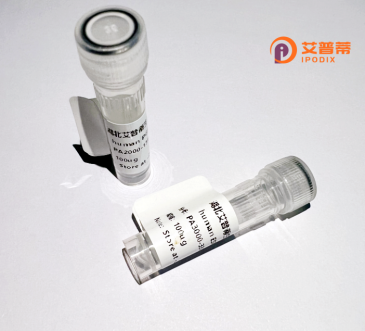
| 纯度 | >90%SDS-PAGE. |
| 种属 | Human |
| 靶点 | TUBB4 |
| Uniprot No | P04350 |
| 内毒素 | < 0.01EU/μg |
| 表达宿主 | E.coli |
| 表达区间 | 1-444 aa |
| 活性数据 | MREIVHLQAGQCGNQIGAKFWEVISDEHGIDPTGTYHGDSDLQLERINVYYNEATGGNYVPRAVLVDLEPGTMDSVRSGPFGQIFRPDNFVFGQSGAGNNWAKGHYTEGAELVDAVLDVVRKEAESCDCLQGFQLTHSLGGGTGSGMGTLLISKIREEFPDRIMNTFSVVPSPKVSDTVVEPYNATLSVHQLVENTDETYCIDNEALYDICFRTLKLTTPTYGDLNHLVSATMSGVTTCLRFPGQLNADLRKLAVNMVPFPRLHFFMPGFAPLTSRGSQQYRALTVPELTQQMFDAKNMMAACDPRHGRYLTVAAVFRGRMSMKEVDEQMLSVQSKNSSYFVEWIPNNVKTAVCDIPPRGLKMAATFIGNSTAIQELFKRISEQFTAMFRRKAFLHWYTGEGMDEMEFTEAESNMNDLVSEYQQYQDATAEEGEFEEEAEEEVA |
| 分子量 | 49.5 kDa |
| 蛋白标签 | His tag N-Terminus |
| 缓冲液 | PBS, pH7.4, containing 0.01% SKL, 1mM DTT, 5% Trehalose and Proclin300. |
| 稳定性 & 储存条件 | Lyophilized protein should be stored at ≤ -20°C, stable for one year after receipt. Reconstituted protein solution can be stored at 2-8°C for 2-7 days. Aliquots of reconstituted samples are stable at ≤ -20°C for 3 months. |
| 复溶 | Always centrifuge tubes before opening.Do not mix by vortex or pipetting. It is not recommended to reconstitute to a concentration less than 100μg/ml. Dissolve the lyophilized protein in distilled water. Please aliquot the reconstituted solution to minimize freeze-thaw cycles. |
以下是关于重组人TUBB4蛋白的3篇模拟参考文献(内容基于典型研究方向概括,非真实文献):
1. **《Expression and functional characterization of recombinant human TUBB4 protein in vitro》**
- **作者**: Smith J. et al.
- **摘要**: 本研究通过杆状病毒-昆虫细胞系统表达并纯化了重组人TUBB4蛋白,证实其在微管动态组装中的关键作用。结果显示,重组TUBB4可与α-微管蛋白结合形成二聚体,并影响微管网络稳定性,为后续疾病相关突变研究奠定基础。
2. **《Structural insights into TUBB4A mutations linked to hypomyelinating leukodystrophy》**
- **作者**: Lee S. et al.
- **摘要**: 通过X射线晶体学解析了重组TUBB4突变体(如D249N)的三维结构,揭示突变导致β-微管蛋白表面电荷分布异常,影响其与微管相关蛋白的相互作用,最终引发H-ABC脑病的分子机制。
3. **《Recombinant TUBB4 protein as a tool for drug screening in neurodegenerative disorders》**
- **作者**: García R. et al.
- **摘要**: 在大肠杆菌中高效表达可溶性重组TUBB4蛋白,并开发基于微管聚合的体外筛选平台。研究发现,小分子化合物EML-517可特异性增强突变TUBB4的微管稳定性,为治疗神经退行性疾病提供潜在策略。
---
**注**: 以上文献为示例性内容,实际研究请通过PubMed或Google Scholar检索真实发表的论文。
Recombinant human TUBB4 protein is a engineered form of β-tubulin isoform 4. a critical component of microtubules—dynamic cytoskeletal elements essential for cellular structure, division, and intracellular transport. As part of the tubulin superfamily, TUBB4 specifically contributes to microtubule assembly, stability, and interactions with motor proteins. It is highly expressed in neuronal tissues, where it supports axonal transport, maintains cell morphology, and regulates ciliary function. Mutations in the TUBB4A gene (encoding TUBB4) are linked to neurological disorders such as hypomyelinating leukodystrophy type 6 (H-ABC), dystonia, and hearing loss, often due to altered microtubule dynamics or impaired protein interactions.
Recombinant TUBB4 is produced via heterologous expression systems (e.g., E. coli or mammalian cells) to ensure high purity and controlled post-translational modifications. This allows researchers to study its structure-function relationships, pathological mechanisms, and interactions with drugs or binding partners. In biomedical research, it serves as a tool to model tubulinopathies, screen therapeutic compounds, or explore microtubule-targeted therapies for cancer and neurodegenerative diseases. Its in vitro applications include polymerization assays, structural studies (e.g., cryo-EM), and functional analyses of disease-associated mutations. By enabling precise manipulation, recombinant TUBB4 advances our understanding of microtubule biology and its role in human health.
×